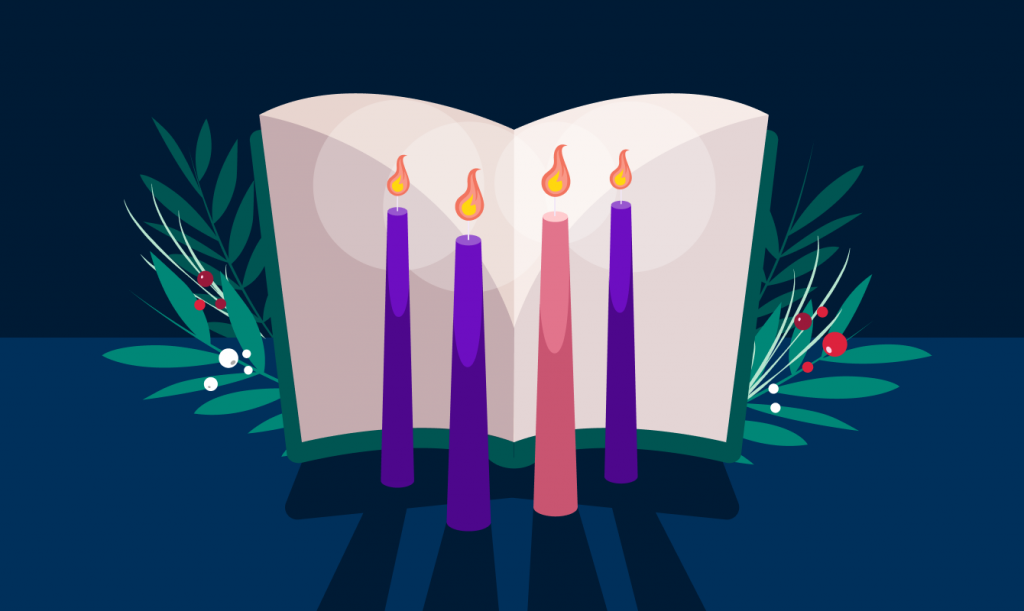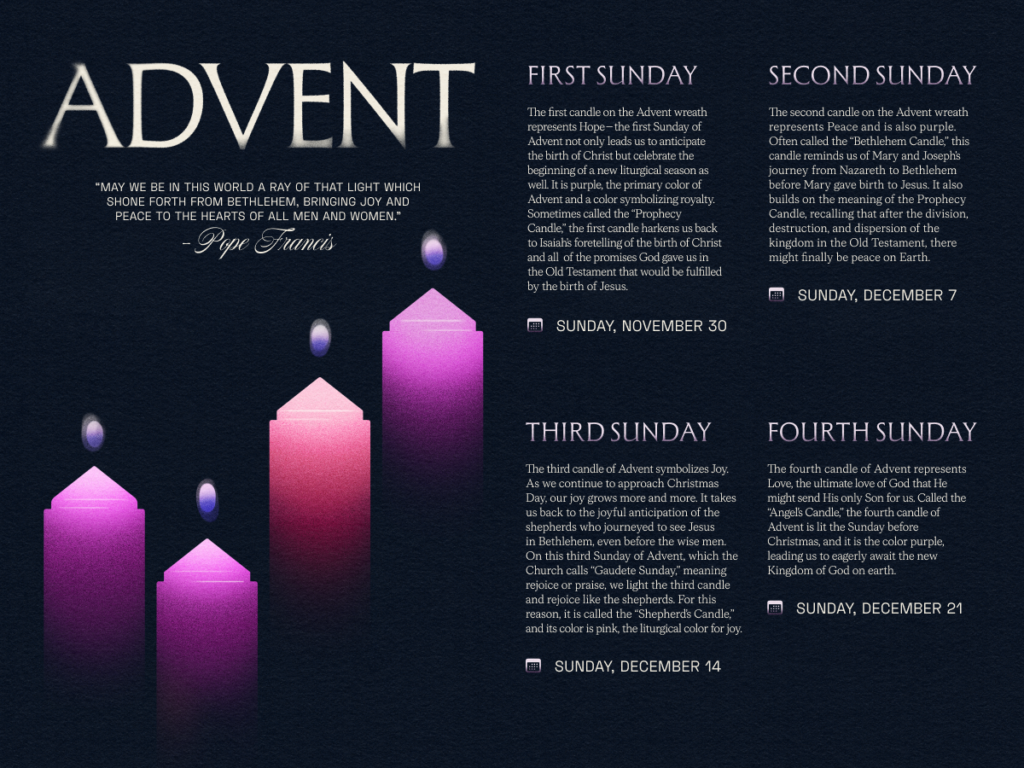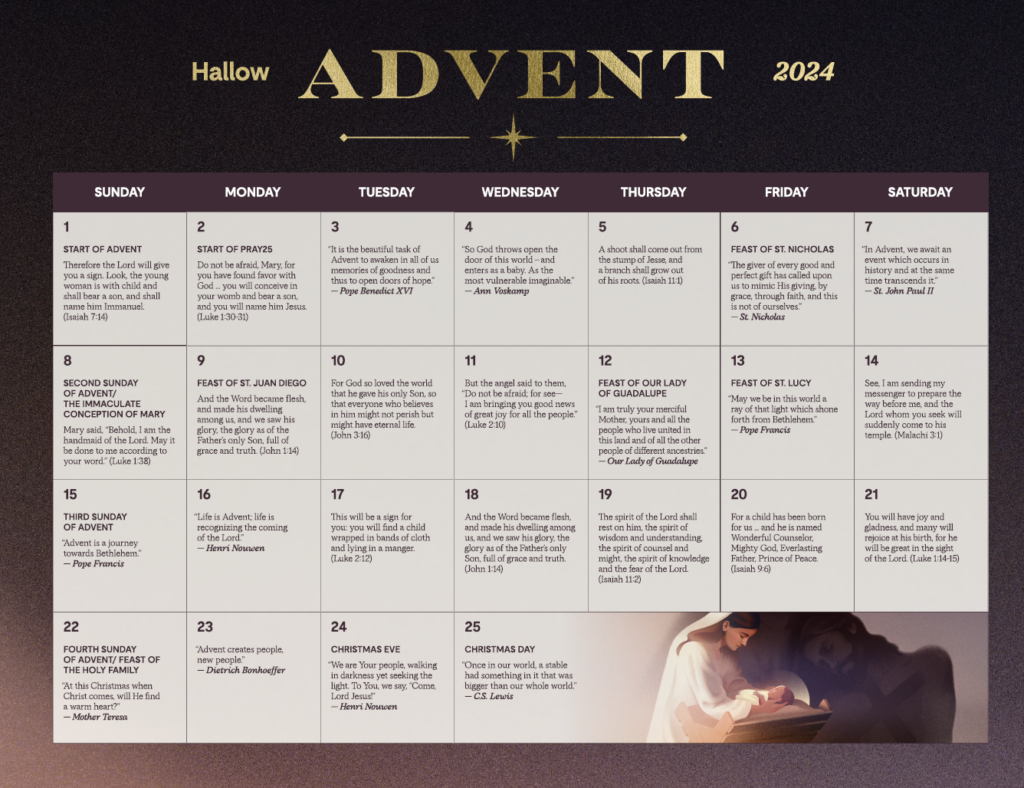Advent is a journey towards Bethlehem. May we let ourselves be drawn by the light of God made man.
Pope Francis
During Advent, we prepare for His coming – He who brought Light into the darkness – for four weeks, represented by the four candles around the Advent wreath.
Table of Contents
- Advent wreaths – history and meaning
- Blessing of an Advent wreath (USSCB)
- Advent candles
- Prayers for lighting Advent candles (Henri Nouwen)
- Related prayers
The word “Advent” comes from the Latin word “adventus,” which means “a coming, approach, arrival.” When we expect guests to arrive at our homes, we turn the lights on; we anticipate their arrival and welcome them with joy. In Advent, we prepare our homes and churches as we joyfully anticipate His arrival, and the light also gets brighter as we near Christmas day, the day on which the Light of the World was born. St. Gregory of Nyssa wrote,
“Today, the darkness begins to grow shorter and the light to lengthen, as the hours of light become fewer. […] Do you see that the beams of light are more intense and the sun higher than it has been? Realize that the true light is now here and, through the rays of the Gospel, is illuminating the whole earth.”
Advent wreaths and candles are commonly seen in Catholic churches during the liturgical season. Many people also display Advent wreaths in their homes and light a candle each Sunday as families. Read more to learn about the history, traditions, and symbolism behind Advent wreaths and candles and how you can celebrate Advent at home with family and friends.
Advent wreaths
The Advent wreath is a centuries-old Christian tradition. Potentially overlooked by the candles it holds to light the way for the birth of Jesus, the Advent wreath itself symbolizes many themes and beliefs central to the Christian faith. In parishes, Advent wreaths are placed anywhere on the altar, on a side table, or even hung from the ceiling. In the home, you might place your Advent wreath on an entry or dining table or another location where you, your family, and your guests can enjoy the wreath during the Advent season.
History of the Advent wreath
The origin of the Advent wreath has been traced back to Germany, though the exact dates are unknown. Historians have suggested that pre-Christian Germanic peoples would light candles around wreaths in the dark winter months in anticipation of the warmer, lighter months in springtime. This tradition likely evolved into an “Advent wreath” at some point during the Middle Ages, transforming the pagan tradition into a Christian one. Rev. William Saunders explained that “By 1600, both Catholics and Lutherans had more formal practices surrounding the Advent wreath.” Ultimately, the Advent wreath tradition spread beyond Germany and into other areas of the world, namely throughout the western Church.
Advent wreath meaning
The circular shape of the Advent wreath symbolizes God’s infinite love for us – it is never-ending, just like the true Light of the World, Jesus, who leads us into eternal life with Him. The materials of the Advent wreath similarly lead us to reflect on the everlasting nature of God; traditionally, Advent wreaths have been made of evergreen leaves, such as pine or fir, which maintain their green color beyond the season in which they are collected. Nowadays, there are many modern interpretations of Advent wreaths that still help us celebrate the traditional meaning of the wreath: preparing the way for the Light of the World, Jesus. Battery-operated/LED wreaths are a good example of this as they simulate the four candles but don’t require lighting each week.
Blessing of an Advent wreath (USCCB)
Time needed: 5 minutes
Pray this blessing from the United States Conference of Catholic Bishops the night before or on the first Sunday of Advent in your home.
- Make the Sign of the Cross.
In the name of the Father, and of the Son, and of the Holy Spirit.
- Say, “Our help is in the name of the Lord, who made heaven and earth.”
- Then, read Scripture from the Book of Isaiah.
The USCCB points us toward Isaiah 9, Isaiah 63, or Isaiah 64.
- Pray with the following blessing written by the USCCB.
“Lord our God,
we praise you for your Son, Jesus Christ:
He is Emmanuel, the hope of the peoples,
He is the wisdom that teaches and guides us,
He is the Savior of every nation.
Lord God,
let your blessing come upon us
as we light the candles of this wreath.
May the wreath and its light
be a sign of Christ’s promise to bring us salvation.
May He come quickly and not delay.
We ask this through Christ our Lord.
Amen.”
Advent candles
What do the four candles of Advent symbolize?
The four candles of Advent represent the four Sundays of Advent, and they respectively symbolize hope, peace, joy, and love. In some homes and parishes, people will also light a fifth candle on Christmas Eve or Christmas Day to represent the birth of Jesus; this candle, when added to the Advent wreath, is typically white and larger than the other candles and is placed in the center of the wreath.
Advent candle weeks, names & colors
- Advent week 1 – Hope: Prophecy Candle (purple)
- Advent week 2 – Peace: Bethlehem Candle (purple)
- Advent week 3 – Joy: Shepherd’s Candle (pink)
- Advent week 4 – Love: Angel’s Candle (purple)
First Advent Candle/Sunday: Hope
“Once in our world, a stable had something in it that was bigger than our whole world.” – C.S. Lewis
It is only fitting that the first candle on the Advent wreath represents Hope – the first Sunday of Advent not only leads us to anticipate the birth of Christ but celebrate the beginning of a new liturgical season as well. The first candle is purple, the primary color of Advent and a color symbolizing royalty. Sometimes called the “Prophecy Candle,” the first candle harkens us back to Isaiah’s foretelling of the birth of Christ and all of the promises God gave us in the Old Testament that would be fulfilled by the birth of Jesus. This Advent, light the first candle on Sunday, December 1, 2024.
Second Advent Candle/Sunday: Peace
“May we be in this world a ray of that light which shone forth from Bethlehem, bringing joy and peace to the hearts of all men and women.” – Pope Francis
The second candle on the Advent wreath represents Peace. Like the first candle, it is also purple. Often called the “Bethlehem Candle,” the second Advent candle reminds us of Mary and Joseph’s journey from Nazareth to Bethlehem before Mary gave birth to Jesus. Building on the meaning of the Prophecy Candle, this second candle recalls that after all of the division, destruction, and dispersion of the kingdom in the Old Testament, there might finally be peace on Earth – Jesus is coming, and so is his Kingdom of Peace. As we read in the quote from Pope Francis, this light of peace shone forth from Bethlehem for all the world. This Advent, light the second candle on Sunday, December 8, 2024.
Third Advent Candle/Sunday: Joy – “Gaudete Sunday”
“But the angel said to them, ‘Do not be afraid; for see — I am bringing you good news of great joy for all the people: to you is born this day in the city of David a Savior, who is the Messiah, the Lord. This will be a sign for you: you will find a child wrapped in bands of cloth and lying in a manger.’” (Luke 2:10-12)
The third candle of Advent symbolizes Joy. As we continue to approach Christmas Day, our joy grows more and more. The third candle takes us back to the joyful anticipation of the shepherds who journeyed to see Jesus in Bethlehem, even before the wise men. On this third Sunday of Advent, which the Church calls “Gaudete Sunday,” meaning rejoice or praise, we light the third candle and rejoice like the shepherds. For this reason, the third candle of Advent is called the “Shepherd’s Candle,” and its color is pink, the liturgical color for joy. This Advent, light the third candle on Sunday, December 15, 2024.
Fourth Advent Candle/Sunday: Love
“And in the end, everything else will turn out to be unimportant and inessential, except for this: Father, Child, and Love.” – St. (Pope) John Paul II
The fourth candle of Advent represents Love, the ultimate love of God that He might send His only Son for us. Called the “Angel’s Candle,” the fourth candle of Advent is lit the Sunday before Christmas, and it is the color purple, leading us to eagerly await the new Kingdom of God on earth. This Advent, light the fourth candle on Sunday, December 22, 2024.
Prayer for lighting Advent candles — Henri Nouwen
Each person or family might approach lighting Advent candles in a different way, which is totally okay! Some families will let different members light a candle each week and say a prayer. What matters most is that the candles remind you of the overflowing hope, peace, joy, and love that the birth of Jesus means for each of us. If you’re struggling to find the words for prayer, this Advent prayer from Fr. Henri J.M. Nouwen encapsulates what many of us feel and hope for during the Advent season:
Lord Jesus, Master of both light and darkness, send your Holy Spirit upon our preparation for Christmas.
We who have so much to do seek quiet spaces to hear Your voice each day.
We who are anxious over many things look forward to your coming among us.
We who are blessed in so many ways long for the complete joy of Your Kingdom.
We whose hearts are heavy seek the joy of Your presence.
We are Your people, walking in darkness yet seeking the light. To You, we say, “Come, Lord Jesus!”
Where to find Advent candles and wreaths?
First, check with your local parish for Advent wreaths and candles. You can also purchase Advent candles and wreaths at local religious stores, from individuals selling on Etsy or personal sites, or through major shopping outlets like Target, Amazon, and Walmart. Or, you can attempt to DIY an Advent wreath and candles by putting together a wreath made of natural materials around your home or neighborhood; then, add purple and pink ribbons around plain white candles to signify the specialty and sacredness of the four Sundays of Advent.
Stay tuned for our #Pray25 Advent Community Challenge on Hallow – we cannot wait to pray with you!


